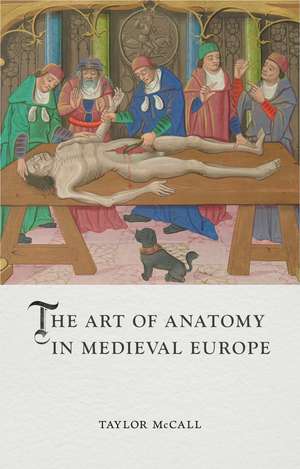The Art of Anatomy in Medieval Europe: Medieval Lives
Autor Taylor McCallen Limba Engleză Hardback – 15 aug 2023
This book is the first history of medieval European anatomical images. Richly illustrated, The Art of Anatomy in Medieval Europe explores the many ways in which medieval surgeons, doctors, monks, and artists understood and depicted human anatomy. Taylor McCall refutes the common misconception that Renaissance artists and anatomists such as Leonardo da Vinci and Andreas Vesalius were the fathers of anatomy who performed the first human dissections. On the contrary, she argues that these Renaissance figures drew upon centuries of visual and written tradition in their works.
Preț: 109.92 lei
Nou
Puncte Express: 165
Preț estimativ în valută:
21.04€ • 21.83$ • 17.58£
21.04€ • 21.83$ • 17.58£
Carte disponibilă
Livrare economică 24 februarie-10 martie
Livrare express 07-13 februarie pentru 33.34 lei
Preluare comenzi: 021 569.72.76
Specificații
ISBN-13: 9781789146813
ISBN-10: 178914681X
Pagini: 232
Ilustrații: 50 color plates, 19 halftones
Dimensiuni: 140 x 216 x 38 mm
Greutate: 0.57 kg
Editura: REAKTION BOOKS
Colecția Reaktion Books
Seria Medieval Lives
ISBN-10: 178914681X
Pagini: 232
Ilustrații: 50 color plates, 19 halftones
Dimensiuni: 140 x 216 x 38 mm
Greutate: 0.57 kg
Editura: REAKTION BOOKS
Colecția Reaktion Books
Seria Medieval Lives
Notă biografică
Taylor McCall is the managing editor of Speculum: A Journal of Medieval Studies.
Recenzii
"McCall dismantles the common belief that Renaissance figures such as Leonardo da Vinci and Andreas Vesalius founded the field of human anatomy. Assisted by vivid medieval illustrations, she argues that the earliest anatomical images date from the twelfth century, in monasteries and then early universities. Her scholarly book, the first in this field, aims to show that such imagery is 'its own visual language', by exploring anatomy in religious contexts, medical teaching and practice, and the work of professional artists."
“There is a myth that medieval Europeans did not understand human anatomy and did not perform human dissections. Taylor McCall’s new book definitively disproves that and has the images to back it up.”
“The image of the so-called Dark Ages leadenly fumbling in crude ignorance is as persistent as all too-easy images are. This little book should completely dispel that image. McCall consults a long list of often obscure written sources and, crucially, deploys a stunning array of the anatomical illustrations that filled so many books from the 12th to the 15th century. Those illustrations are the central wonder of the book; they immediately transport the reader to an earlier world full of desperate speculation and the inevitable melding of anatomical studies and the cosmologies of organized religion.”
"The Art of Anatomy in Medieval Europe makes the case for the intellectual richness of renderings of the interior of the human body during this period, and the precise and detailed meanings inherent in such images . . . Like the other entries in Reaktion’s Medieval Lives series, McCall’s book combines a crisp and concise writing style with cutting-edge scholarship . . . an intellectually rich and satisfying read."
"This book succeeds in providing a compelling overview of the history of medieval anatomical art and dissection, something that has been lacking since Karl Sudhoff’s pioneering explorations of the early twentieth century."
"McCall offers an exciting new overview of the deep connections between visual and medical culture during the European Middle Ages. An important revision to the outdated caricature of medieval anatomy as intellectually and artistically backwards, this book tours the rich and varied personalities—monks, university anatomists, physicians, artists, and artist-anatomists—who generated both detailed knowledge and eloquent visualizations of the bodily interior. What results is a powerful argument: that medieval people had a close interest anatomical form, striving to innovate how the body was understood and how it was pictured."
"McCall's The Art of Anatomy in Medieval Europe is rich and scholarly, full of images both gorgeous and grisly and giving much needed attention to medieval anatomical art."
"This is a clearly written, well-argued, and lavishly illustrated book, which appeals to several audiences unlikely to be in dialogue with each other. Both historians of medicine and art historians will appreciate this book, the former by seeing the artistic context, and the latter by seeing the medical context, in which these images developed. This book could also be assigned to students in upper-level courses, especially in the history of science."















